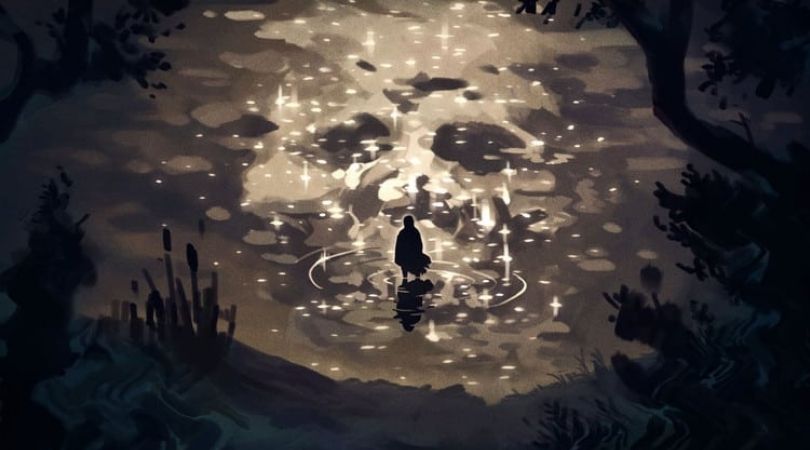I have long been in love with the ability of Mary Shelley’s Frankenstein to showcase the fears of otherness in humanity. A reanimated creation of Dr. Frankenstein, Shelley’s creature and his experience has been the exemplar of fearing otherness, a monster to those who see him but a mirror held up to humanity for readers. The Wanderer: Frankenstein’s Creature is the latest gaming take on Frankenstein’s monster.
Published and co-produced by ARTE alongside indie game studio La Belle Games, The Wanderer is a story-driven point-and-click game that aims to go back to the roots of Mary Shelley’s legendary novel Frankenstein. As the creature, you begin neutral, not good, not evil, but learning the world and traveling through Europe in search of its origins and learn about humanity and acceptance.
The format of The Wanderer is one that immerses the player in the story. The text tells the story on the screen as atmospheric music plays in the background. The text is a perspective from the future as you live it out, building out the world around you in color and scale as you learn more about it. The Wanderer visually shows the Creature learning, illuminating black and white areas with technicolor or in some cases a deep gray or red palette, all of which is dictated by the choices you make in the environment.
This journey is emotional and challenging for both the creature and the player as beauty and kindness are often followed by darkness, fear, and hate. Depending on the player’s decision, the landscape and the soundtrack evolve throughout the game. The handcrafted watercolor environments, inspired by the Romantic era, change from light and colorful to dark and moody, underlining the emotional atmosphere of the game.

These choices, ranging from hugging a statue too long, to eating from a carcass, or deciding to retaliate against a mob impact your gaming experience, both narratively and visually. Additionally, your choices in dialogue also impact the story. While a bind-play through of the game doesn’t tell you this, but by the time you clear through a few chapters you realize what the shifts in color after your actions mean.
Additionally, you can interact with your environment, clicking on predesignated items, to eat, drink, and read. Now, none of this is open exploration but rather linear interactive choices and objects that has the Creature learn in different ways. One of the most interesting levels is bathed in religion, a common theme used to explore the Creature’s own creation and morality. In it, you walk up a hill, with the remnants of a church and a cemetery decorating it.
As you explore the land becomes vibrant or it becomes a gray and black wash. But what makes this scene stand out is the choice you have to make, picking the scripture that reflects your identity as the creature, saying that you need redemption or damning yourself. The Wanderer, while instituting a simple narrative asks you to judge yourself. Are you the monster that townspeople say that you are? Is it because of your actions? Or are you truly a misunderstood soul wandering for acceptance.
The gameplay itself is extremely simple, stripped down to one action – click on the screen. The game opens with a white screen. Out of it, the image of you, the Creature emerges as the watercolors moves and you begin to read the story. Born into the world, unsure of what you are, where you are, you move through the white screen, the black and gray landscape begins to reveal itself. The slow-moving nature of the game helps you take in the story, which is beautifully written

The Wanderer’s visual style allows the game to pull you into the story. You know as much as the Creature does, moving the world blindly as they do. A small piece of a large world, the exploration is wide even if the click and point mechanic isn’t always consistent in steering your character. Watercolors and an impressionist style make The Wanderer stand out against other games. Its art is beautiful and it deserved to be framed on someone’s wall.
In addition to the narrative choices, The Wanderer also offers up puzzles and interactive musical moments that are sometimes one and the same. But sadly, they aren’t challenging, and while this may work for some players to keep them in the story, for me, it disconnected me, and with no option to increase difficulty, even if it was making the painfully slow timed pieces of the game slightly faster, it meant I sped through The Wanderer. The ease made the game a tad boring and caused me to disconnect even with the beautiful story.
Truthfully, having just completed Skybox Labs’ Stela, a cinematic game with no dialogue (written or spoken), moved by its artistry and music, The Wanderer leaves me wanting so much more. There is no difficulty in traversing the game’s world, which doesn’t work for my playstyle. That said, for those looking for a haunting story set to beautiful art The Wanderer: Frankenstein’s Creature is for you.
The Wanderer: Frankenstein’s Creature is available on Steam for Windows PC and Mac and The Nintendo Switch.
The Wanderer: Frankenstein’s Creature
-
Rating - 7/107/10
TL;DR
The Wanderer leaves me wanting so much more. There is no difficulty in traversing the world of the game which doesn’t work for my playstyle. That said, for those looking for a haunting story set to beautiful art The Wanderer: Frankenstein’s Creature is for you.





